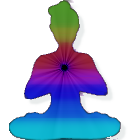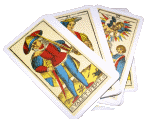I consider a tarot card to be a sum of its parts, deriving its personality from many different sources and interpretations, of both the card itself and the different symbols within a card. The Hanged Man is a fabulous example of this idea. It covers a whole range of topics like crucifixion and sacrifice, the upside down hanging of traitors, enlightened masters, ancient alphabets, betrayal, martyrdom, flora, and numerology.
Twelve
12 is an interesting number. There are 12 hours in the day and in the night, 12 apostles, 12 solar months a year, 12 houses of the zodiac, 12 days of Christmas, 12 tribes of Israel, 12 Knights of the Round Table.
We can see different faces of the Hanged Man’s personality by manipulating the number 12 in different ways. Reduced to 3 (1+2=3) we find the number of the trinity, spirit, and the Empress, nurturing and life giving. Divided into 10+2 we get the Wheel plus the High Priestess, apparent randomness but with secret knowledge and order. 3X4 =12 is a very special combination. 3 is the number of the feminine trinity and spirit, and 4 is the number of masculine stability, the 4 elements, and physical matter. Multiplying them together imbues each aspect of earth with spirit making it a very complete creation.
12 being the number of solar months as opposed to the 13 lunar months in the year is very meaningful. 12 is the completion of a masculine, physical cycle where 13 is the completion of a feminine, spiritual one. In the case of the Hanged Man he has forsaken his body, sexuality, and matters of the material world as a last step in completing a spiritual cycle, as in the case of a bodhisattva who forsakes his own entry into Nirvana to help other people. Compassion and ego-less-ness are a last step on their journey to spiritual completeness, transcending the wheel of reincarnation and achieving eternal bliss.
Shadow Side
Despite what appears at first to be a comforting spiritual card, this card does cause feelings of discomfort. To see someone hung upside down makes you empathetically feel vulnerable, helpless, trapped and stuck. The hanging man is being punished for something; did he deserve it? (Do you deserve it?) Was he betrayed? Are there people who are cruel enough to do this to another living soul?
He is surely sacrificing something, his freedom, his ability to right himself, his dignity, his possessions and if he is left there long enough, his life. Is there pain? Was he nailed to it, are ropes tearing at his skin? Is his head full of blood and his appendages losing their feeling?
I think it is natural to feel sympathetic toward another being when we sense they are in distress, even when it is just an illustrated card. I do think this card contains that element, however, not only for the one who is being hung, but also for those who are observing it. This is the dark side of the hanged man.
Sacrifice
In many decks, including this one, if you look at the Hanged Mans face there is no trace of pain or agony. Perhaps you will find a shred of ecstasy. The Hanged man could be doing this willingly. He could be forsaking his body, his material possessions, and his freedom in order to free his soul to do other spiritual work. Like a bodhisattva, he is giving of himself in order to help others. To one who is enlightened, as this aspect of the Hanged Man is, there would be no pain in this; he would see the material world as just a small part of his true body and identity.
There is a story about one of Buddha’s previous incarnations. He was walking through the forest and heard a sound. He looked over the edge of a cliff to find its source and there on a ledge were 4 starving tiger cubs and their starving mother who was too weak to acquire them food. The Buddha immediately threw himself off the cliff so his body would provide food for the tigers.
The above story is an excellent metaphor for the sacrifice a bodhisattva makes to help others. Without thought or hesitation he helps another, no matter what the price to himself, for he knows that he and the tigers are not truly separate. The tigers, a symbol of strength, everlasting life, and the road to enlightenment, are what a bodhisattva gives up of himself to provide for others. He helps others achieve enlightenment.
The Vine
In the Mary-el deck the Hanged Man is suspended from a vine. The vine to Christians is a symbol of everlasting life, to pagans it is renewal and resurrection, to a Shin Buddhist the wisteria vine, as illustrated here, is a symbol of great humility and reverence to the Amida Buddha. He is called the everlasting light. He was a previous incarnation of Siddhartha Gautama and was said to be the ideal Buddha that lived in Siddhartha's mind and heart. Amida Buddha is the embodiment of compassion, wisdom, and enlightenment.
As a bodhisattva, Amida refused to accept Buddhahood unless he could grant people eternal happiness in the Pure Land. Now anyone who calls to Amida sincerely will receive eternal life and happiness. The reason the wisteria vine is associated with Amida Buddha is because the flowers of the wisteria grow in long drooping clusters that grow downward in humble supplication. A Shin Buddhist says that the lower a man's head goes the more sincere and humble he will become.
The grape vine, also with its downward growing purple-fleshed fruit, has the additional symbolism of producing wine, a traditional symbol for blood, life-force.
Jesus said of the vine, “I am the vine; you are the branches. If a man remains in me and I in him, he will bear much fruit; apart from me you can do nothing”. John 15:5.
We see here in the vine a connection to the source of all. We, as individuals, are the branches on that vine. We not only come from the same source, but remain connected to it and to all other creations. Our actions affect the whole and we are a living manifestation of that whole. When we receive a good balance of sunlight, darkness, earth, and water, we will grow to our greatest potential and bear fruit.
The Tau Cross
The Silhouette of the man on the vine creates the shape of the Tau cross, so called because of its resemblance to the last letter of the Hebrew alphabet Tau, as it sometimes appeared in ancient times before Hebrew was a uniformly drawn alphabet. Tau literally means cross.
The Hebrew alphabet is a very important part of Jewish mystical thought. God spoke the universe into existence and every letter in the alphabet is creative and has spiritual meaning. Being the last letter of the Hebrew alphabet, Tau is said to contain the essence of every letter that preceded it. It not only carries the attributes of all of the Hebrew letters, it contains the map from the beginning to the end of the alphabet. This is very profound because to have a man hanged from the Tau cross is to say he contains the essence of all there is from the beginning to the end and he knows the way there. I can think of no better way to display enlightenment, and how beautiful that instead of climbing up and reaching his bliss, the man hangs himself, suspends himself, in order to bestow his compassion on others who need him.
The beloved St. Francis of Assisi was very fond of the Tau cross. Ezekiel wrote of his vision that the followers of God were marked with a Tau cross on their foreheads; St. Francis liked this very much and adopted the Tau cross as his own signature.
St Francis gave all of his worldly possessions to those less fortunate and devoted himself to caring for people without prejudice of class, state of disease or even species; he was said to preach to animals as well, never finding anyone, or anything, to be unworthy. He attempted to be Christ-like in poverty, humility, giving freely of himself and in doing the will of God. He founded the Franciscan order of monks, who on their crest bear the symbol of a Tau cross with two arms crossed in front, with the stigmata on their hands. It appears very similar to the crossed arms in the Mary-el Hanged Man. Two years before St. Francis died he received the stigmata on his hands.
Another to have given his life in humility upon the cross was St. Peter. He was said to refuse to be crucified in the same manner as his lord Jesus and requested that he be hung upside down, which he was.
The Traitor
As an interesting twist on these stories, some of the old Hanged Man cards were titled Il Traditore, the Traitor, and referred to the tradition of punishing traitors by hanging them upside down and publishing their hung image as a so called shame poster. Some old cards also depict coins falling out of the Hanged Man’s pockets. These could refer to the money Judas was paid to betray Jesus.
The coins do have a double nature. As the traitor is losing his booty to gravity, so is the enlightened master losing his attachments to things material. Also the material world is falling away, as would happen to one hung too long as he moved into death.
A New Beginning
In the meantime the Hanged Man remains suspended in a region between spirit and matter, not fully in the spirit and no longer completely of the flesh. Another aspect of the Hanged Man is that he is in a state of transition himself, still dancing around the wheel of incarnations, awaiting birth into a new form. He hangs from the vine, upside-down like a butterfly surrounded by a chrysalis of energy or a baby in a protective amniotic sack. The energy flows around him and through him, freely, and emanates from his hands in great colorful sheets, connecting him, as a crossroads, to all that there is.
Keywords:
Crucifixion, martyrdom. Suspension, reversal, upside-down, backwards, mirrored. Paralyzed, trapped, stuck, vulnerable, helplessness. Punishment, pain, distress, purgatory. Betrayal, traitor. Forsaking matter, letting go of attachment, poverty, material objects falling away, material disconnection, asceticism, self denial. Spiritual suspension, imbalance of body and spirit, favoring the spirit, receding into spirit. Cocoon, developing, waiting, stasis. Coming into existence, transition, crossroads. Period before life, eternal life, resurrection, life after death. Bodhisattva, enlightened, compassion, forgo ones goals for another’s, awareness beyond matter, selflessness, weightlessness, acceptance, surrender, sacrifice of self. Reflection, meditation, devotion, humility.











